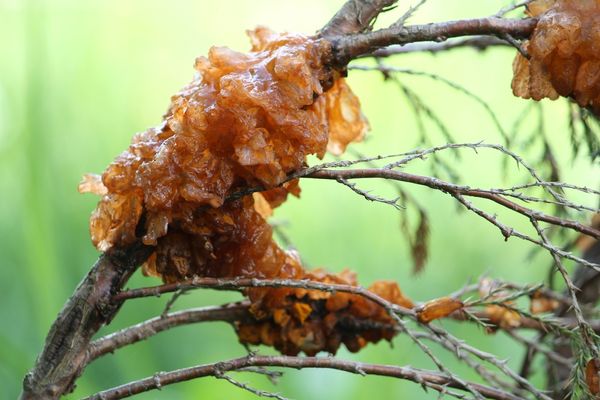Taking care of plants in your backyard can be a rewarding experience. It does, however, present a substantial number of obstacles. You may occasionally come upon strange things that make you scratch your head. A Reddit user from Oklahoma recently noticed something unusual in their trees: a big amount of yellow jelly and what they dubbed a “jelly alien nut.” Perplexed and fascinated, they turned to the internet community for clarity.

Cedar-apple rust was discovered as the cause of this mysterious phenomenon. It requires two hosts to complete its life cycle, and the most common hosts are apples and crabapples. Despite the name, which implies that cedars are involved, juniper trees can also suffer it.
How to Identify Cedar-Apple Rust.
Cedar-apple rust causes varying symptoms depending on the type of tree it infects. Brown, persistent galls may be found on juniper twigs. As spring weather becomes wetter, these galls produce orange gelatinous horns. The twig farther away from the gall may perish, but the juniper host is unaffected.
Crabapple and apple trees’ leaves get circular yellow blemishes shortly after they bloom. As the summer progresses, these lesions develop into brownish thread tufts or cylindrical tubes. They appear beneath the spots on fruits, twigs, and leaves.

Understanding the Life Cycle
You may be wondering how long this ailment lasts. Galls begin to form about seven months after the first sickness. They become into gelatinous lumps after 18 months. The next spring, telial horns sprout from golf-ball-shaped depressions on the galls. The brownish telial horns expand and turn bright orange in the spring rain. After releasing their spores, the horns eventually weaken, become parched, and fall off. The galls remain adhered to the tree for at least a year after death. When the galls are covered with gelatinous masses in the spring, the infection is most obvious.
Handling Apple-Cedar Rust.
Fortunately, treating this infection is not difficult. Trim off the infected sections to prevent the infection from spreading further. It’s crucial to remember that cedar-apple rust only affects the appearance of the plants and will not kill your trees. If you prefer to be proactive, you can select apple cultivars that are resistant to this disease or apply fungicides.
In summary:
To summarize, while cedar-apple rust may be unusual in your backyard, it poses no severe harm to your trees. It is crucial to understand this virus so that you can respond appropriately if it develops. Spread the word about this information so that others can recognize and understand cedar-apple rust. Cheers to your successful gardening!